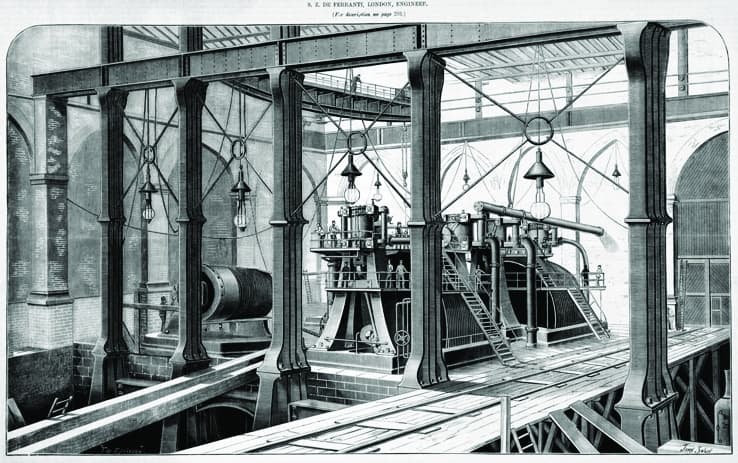As witnessed in this 1888 report, the London Electric Supply Corporation (LESCo) were alert to his talents and they approached him to design the Deptford Generating Station, a facility acknowledged as being the first modern power station.

Interestingly, certain comparisons can be made between the claims made by the developers of today’s power stations and those of LESCo.
It isn’t unusual for today’s power station developers – be they wind, coal or nuclear et al – to make claims about the number of homes their installations will supply.
Keen to quantify their output, LESCo measured their productivity in the number of light bulbs their power station could help to illuminate.
This quaint reflection, however, shouldn’t mask another of Ferranti’s many achievements, namely his part in ensuring the implementation of alternating current.
As the following excerpt shows, The Engineer clearly admired the possibilities of LESCo’s Central Station at Deptford, itself a fitting tribute to Ferranti’s legacy.
‘The directors claim, and we think they are justified in making the assertion, that when completed their station will be the most remarkable industrial establishment in the metropolis.
‘The engines will run at sixty revolutions, and will drive, by means of forty 5in cotton ropes working over a 24ft drum, two Ferranti dynamos, each capable of supplying current for 25,000 lights, by far the largest electrical generators that have as yet been constructed.
‘The river frontage (which is some 780ft by 190ft) having been procured by the corporation, the two questions presented themselves for solution, first, the most economical method of getting the current up to town.
‘With a view to solve the first question, Mr Ferranti made a number of experiments with different electro-motive forces of alternating currents, and finally settled upon 10,000 volts as being the most economical pressure at which to work, having regard not only to the small loss in the mains, but also to the design of the transformers and dynamos which have to resist such severe tension. It is needless to say that very special and novel designs were necessary for the apparatus used…
‘The whole of this station, both architectural and mechanical, has been designed by Mr Ferranti personally, and the numerous novelties which are being introduced into it are fully covered by a large number of his patents.
‘The electro-motive force of 10,000 volts may cause some surprise to the electrical world, but a number of careful experiments have shown that 10,000 volts is no more difficult to deal with than 2,400 volts if the right principles are employed in designing the machinery.
‘Mr Ferranti, in designing the station and its details…has a space at his disposal now covered with buildings capable of accommodating 40,000 horse power and remaining space of ground easily available without crowding for another 80,000 horsepower. This brings up the capacity of the three acres of ground, after everything has been provided for, to the enormous figure of 120,000 horse power. These again will be, no doubt, startling figures, but anyone who will quietly consider the requirements of the metropolis for electric lighting will see that this is only a small step toward its fulfilment.
‘Before leaving the description of the buildings, we may state that they are being laid down on the lines which will admit an ultimate output of current for 2,000,000 lamps, and that the present preliminary arrangements will, as already shown, admit of 250,000 lamps being run.
‘The alternating current, produced by the Ferranti generators, is to be conveyed at a pressure of 10,000 volts, from it source to distributing stations situated in various parts of London, where it will be reduced to the required tension and distributed over the district of which the particular distributing station forms the centre.
‘Although conveying currents of such high tension, the Corporation have proved to demonstration that their mains do so with absolute safety.’
Click here to read the complete report.

Poll: Should the UK’s railways be renationalised?
I think that a network inclusive of the vehicles on it would make sense. However it remains to be seen if there is any plan for it to be for the...